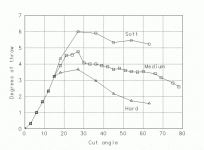I'm interested to know where it was stated exactly as "CTE takes care of throw for any shot." What I understand is "CTE has an overcut to compensate for CIT." I think its pretty clear if you take a specific shot, and the only variable you changes is speed, the throw (depending on the severity of cut) will vary. Also, you would likely not change the CTE perception on the given shot, meaning you are not going to change the cut angle. So something has to give, yes? Now when I hit a very typical, medium speed to firm hit, and my stroke is true, the ball tends to travel to center pocket. If I hit very softly, I'm going to compensate, from experience, with high or outside spin. If I hit very hard, I don't *think* I consciously change anything, and also my shot percentage goes down dramatically. That's why I don't slam balls into pockets. The game will almost never call for that, and my stroke isn't going to bode well, and my game would suffer from it. I think (and I'm fine to be corrected) that the CTE overcut is addressing the large majority of shots that fall in the medium/firm range. For shorter shots, its even less of an issue. For longer shots, you have to work from experience to know what to address for the given shot. Firing in table-length cut shots at warp speed is probably not going to win you very many trophies.
Very true. Although this has all been stated already, just not with a big X for those that don't want to read the map to see where they are going.
If Dan would actually read with the end goal being to learn instead of to see what he can nit pick next, he would already know this.
They have ears, but do not hear. Eyes, but do not see.
